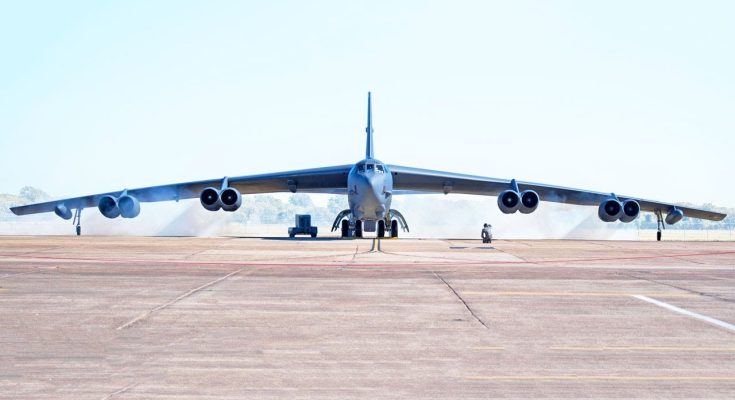B-52 Stratofortress Take Off: A Symbol of U.S. Air Power and Global Reach
The B-52 Stratofortress is a long-range, strategic bomber that has served as a cornerstone of the U.S. Air Force’s global strike capability for over six decades. When the B-52 takes off, it is not just a demonstration of aircraft power but a clear reminder of the U.S. military’s ability to project force anywhere in the world. Capable of carrying out a variety of missions—from nuclear deterrence to conventional airstrikes—the B-52 continues to play an integral role in ensuring U.S. air dominance and national security.
B-52 Stratofortress: An Iconic Aircraft
Developed by Boeing in the 1950s, the B-52 Stratofortress was originally designed as a nuclear-capable bomber to carry long-range bombing missions. However, over the decades, it has evolved into a versatile multirole platform, capable of executing a wide range of operations beyond nuclear deterrence. Despite its age, the B-52 remains one of the most powerful bombers in the U.S. Air Force, undergoing continual upgrades to keep it relevant in modern combat scenarios.
- Role: Long-range strategic bomber
- Crew: 5 (Pilot, Co-pilot, Radar navigator, Navigator, Electronic warfare officer)
- Length: 159 feet, 4 inches (48.5 meters)
- Wingspan: 185 feet (56 meters)
- Top Speed: 650 mph (1,050 km/h)
- Combat Radius: 2,400 nautical miles (4,400 km)
- Armament:
- Nuclear weapons: Cruise missiles, gravity bombs
- Conventional weapons: Precision-guided munitions (JDAM), cluster bombs
- 1 × M61 Vulcan gun (20mm)
- Avionics: Advanced radar, GPS, and electronic warfare systems
The B-52’s ability to carry a large payload of both conventional and nuclear weapons, combined with its long-range and high endurance, makes it a critical asset in ensuring U.S. global dominance. The bomber is designed to carry out missions ranging from strategic deterrence to conventional combat operations, giving it unparalleled flexibility.
The Takeoff: A Show of Power and Precision
When the B-52 Stratofortress takes off, the sheer size and power of the aircraft are awe-inspiring. With its eight turbofan engines mounted on the wings, the B-52 can reach speeds of up to Mach 0.9 and has the ability to travel vast distances without needing to refuel. The takeoff from the runway involves careful coordination, with the aircraft’s engines roaring to life as the bomber begins its ascent.
The takeoff itself is a critical moment in any mission, marking the start of a deployment or a long-range strike operation. Whether it’s conducting a combat mission or part of a show of force, the ability of the B-52 to take off from a conventional runway ensures that it can be deployed across a wide variety of environments, from air bases in the U.S. to forward-deployed locations globally.
Once airborne, the B-52’s long endurance allows it to remain in the air for extended periods, making it ideal for missions requiring high persistence and the ability to strike at critical moments. The B-52 is often accompanied by escort aircraft during high-risk missions, providing protection and ensuring mission success.
Operational Flexibility and Strategic Importance
One of the key advantages of the B-52 Stratofortress is its operational flexibility. It is capable of performing a wide range of missions, including:
- Nuclear Deterrence: The B-52 is a key component of the U.S. nuclear triad, providing a flexible and survivable option for nuclear deterrence. Its ability to carry nuclear weapons ensures that it can serve as a strategic deterrent in the face of potential adversaries.
- Conventional Bombing: The B-52 can carry and deliver precision-guided munitions (PGMs), making it a critical asset in conventional bombing operations. This capability allows the bomber to strike strategic targets with precision, providing support for ground forces or conducting air interdiction.
- Close Air Support and Maritime Strike: In addition to its primary role as a strategic bomber, the B-52 can also perform close air support and maritime strike missions, helping to engage targets in dynamic operational environments.
The bomber is also capable of participating in global operations, whether by conducting combat air patrols (CAP) or by providing show-of-force missions to signal U.S. resolve in sensitive regions. Its ability to operate from overseas bases allows the U.S. Air Force to project power across the globe, reinforcing strategic partnerships and ensuring regional security.
A Legacy of Readiness and Deterrence
The B-52’s ability to take off and perform a wide variety of missions speaks to its continued relevance in modern military operations. The aircraft’s enduring presence in the U.S. Air Force ensures that the nation retains a credible nuclear deterrent and a rapid-response capability to any conventional conflict. Over the years, the B-52 has participated in numerous conflicts, from the Vietnam War to more recent operations in the Middle East.
Its continued service is a testament to its adaptability and the successful integration of new technologies that have kept it at the forefront of U.S. military strategy. The B-52’s role in global stability and military deterrence is unmatched, and it continues to play a central role in ensuring the U.S. maintains air superiority and strategic influence worldwide.
Conclusion
The B-52 Stratofortress is a symbol of U.S. air power—a versatile and powerful bomber that has been integral to the U.S. Air Force for over 60 years. When it takes off, it represents more than just a flight; it represents a commitment to global reach, nuclear deterrence, and conventional strike capabilities. With its ability to carry both conventional and nuclear weapons, its long endurance, and operational flexibility, the B-52 remains a cornerstone of U.S. military operations and a formidable presence on the world stage.



